Generac 005753-0, 005856-0, 005411-0, 005415-0, 005855-0 User Manual
...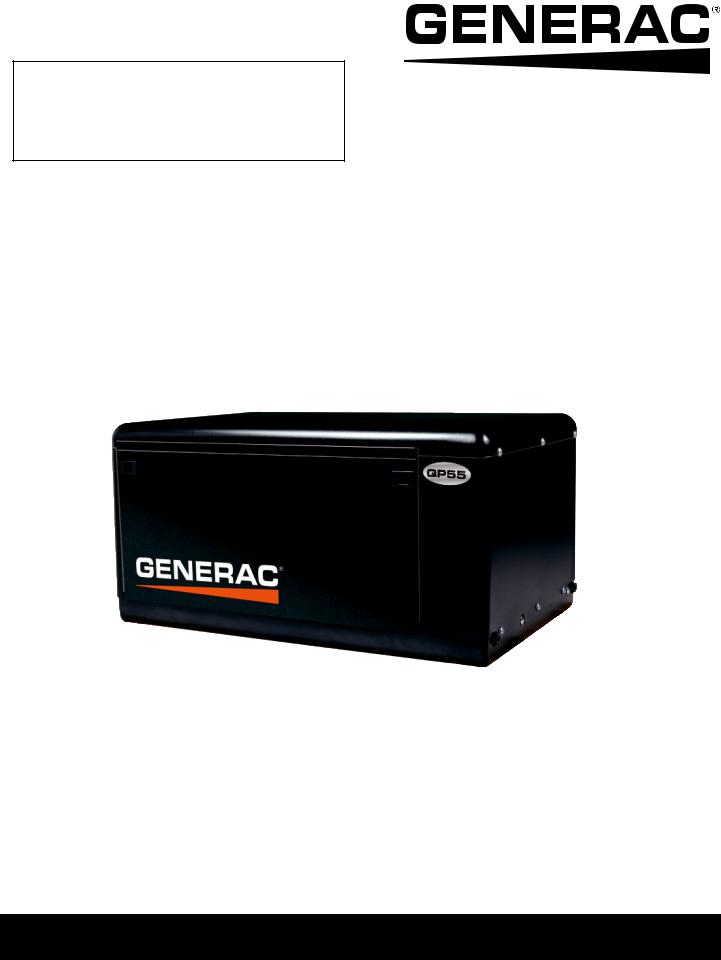
Models:
005411-0, 005413-0, 005415-0, 005751-0, 005752-0, 005753-0, 005855-0, 005856-0, 005857-0
Owner's Manual
Air-cooled Recreational
Vehicle Generators
RV 45, 55 and 65
www.generac.com or 1-888-GENERAC

Table of Contents |
|
|
|
Part I — Operating Instructions |
|
Introduction .............................................................. |
1 |
|
Read This Manual Thoroughly........................................... |
1 |
|
Contents ............................................................................. |
1 |
|
Operation and Maintenance .............................................. |
1 |
|
How to Obtain Service ....................................................... |
1 |
|
Authorized Service Dealer Locator Number.......................... |
1 |
|
Safety Rules ............................................................. |
2 |
|
Section 1 – General Information ............................. |
4 |
|
1.1 |
Generator Identification .............................................. |
4 |
1.2 |
Generator Applicability ............................................... |
5 |
1.3 |
Installation ................................................................... |
5 |
1.4 |
Safety .......................................................................... |
5 |
1.5 |
Generator AC Connection System............................. |
5 |
1.6 |
Specifications.............................................................. |
6 |
1.7 |
Exhaust Emissions Information (Gasoline) ................ |
7 |
1.8 |
Evaporative Emissions Information ............................ |
8 |
Section 2 – Operation .............................................. |
8 |
|
2.1 |
Generator Control Panel............................................. |
8 |
2.2 |
Optional Remote Start/Stop Panel ............................. |
9 |
2.3 |
Automatic Choke ........................................................ |
9 |
2.4 |
Before Starting the Engine ......................................... |
9 |
2.5 |
Starting the Generator .............................................. |
10 |
2.6 |
Stopping the Generator ............................................ |
10 |
2.7 |
Applying Loads to Generator ................................... |
10 |
2.8 |
Protection Systems................................................... |
11 |
Section 3 – Maintenance........................................ |
12 |
|
3.1 |
Checking the Engine Oil Level ................................. |
12 |
3.2 |
Changing the Engine Oil and/or Oil Filter................ |
12 |
3.3 |
Maintaining the Engine Air Cleaner.......................... |
13 |
3.4 |
Checking the Engine Spark Plug ............................. |
13 |
3.5 |
Fuel Filter (Gasoline Only)........................................ |
13 |
3.6 |
Clean Spark Arrestor ................................................ |
14 |
3.7 |
Cleaning the Generator ............................................ |
14 |
3.8 |
Battery Maintenance ................................................. |
14 |
3.9 |
Adjusting Valve Clearance........................................ |
15 |
3.10 |
Major Service Manual ............................................... |
16 |
3.11 |
Drive Belt................................................................... |
16 |
3.12 |
Exercising the Generator .......................................... |
16 |
3.13 |
Out of Service Procedure ......................................... |
16 |
3.14 |
RV Generator Service Interval .................................. |
16 |
Part II — Installation Instructions |
|
Safety Rules ........................................................... |
18 |
Notice to Installer ............................................................. |
18 |
Section 1 — General Information.......................... |
20 |
1.1Purpose and Scope of the Installation
|
Instructions................................................................ |
20 |
1.2 |
Safety ........................................................................ |
20 |
1.3 |
Standards Booklets .................................................. |
20 |
1.4 |
Equipment Description ............................................. |
20 |
1.5 |
Generator Engine Operating Speed ........................ |
20 |
1.6 |
Generator AC Connection System........................... |
20 |
Section 2 — Installation......................................... |
21 |
|
|
Major Features and Dimensions .............................. |
21 |
2.1 |
Location and Support ............................................... |
22 |
2.2 |
Generator Compartments......................................... |
23 |
2.3 |
Cooling and Ventilating Air ....................................... |
25 |
2.4 |
Gasoline Fuel System............................................... |
27 |
2.5 |
Exhaust System ........................................................ |
28 |
2.6 |
Electrical Connections .............................................. |
29 |
2.7 |
Battery Installation .................................................... |
30 |
2.8 |
Optional Accessories................................................ |
32 |
Section 3 — Post Installation ................................ |
33 |
|
3.1 |
Post Installation Tests ............................................... |
33 |
3.2 |
Before Initial Start-up ................................................ |
33 |
3.3 |
Initial Start ................................................................. |
33 |
3.4 |
Testing Under Load................................................... |
33 |
3.5 |
Installation Checklist ................................................. |
34 |
Section 4 – Troubleshooting.................................. |
35 |
|
4.1 |
Troubleshooting Guide ............................................. |
35 |
Section 5 – Electrical Data..................................... |
36 |
|
Section 6 – Exploded Views and Parts Lists ........ |
40 |
|
Section 7 – Warranty.............................................. |
52 |
|
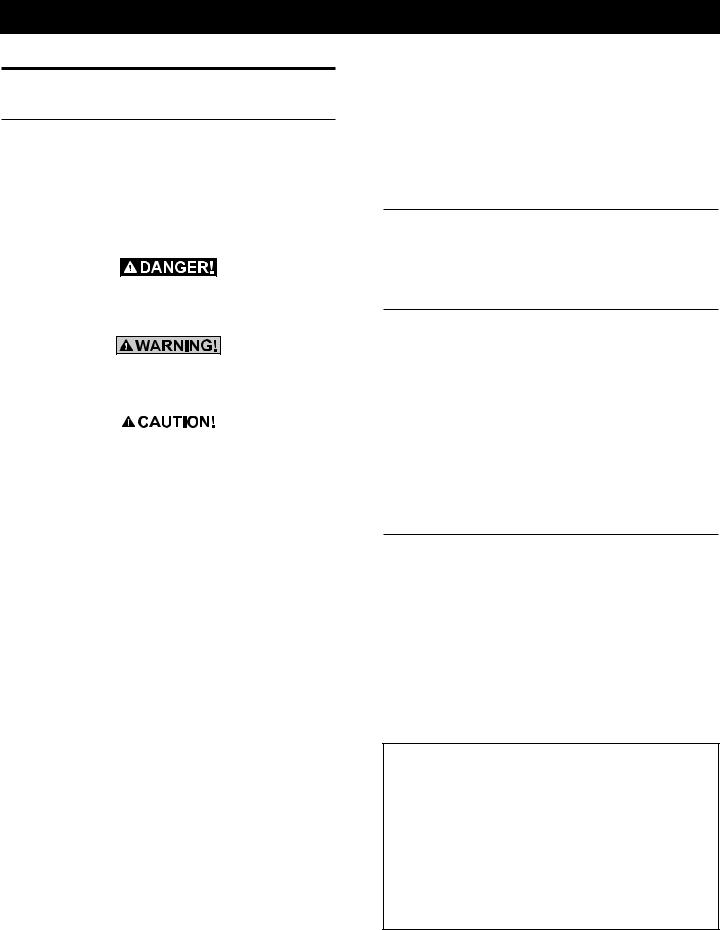
INTRODUCTION
READ THIS MANUAL THOROUGHLY
If any portion of this manual is not understood, contact the nearest Authorized Service Dealer for starting, operating and servicing procedures.
Throughout this publication, and on tags and decals affixed to the generator, DANGER, WARNING, CAUTION and NOTE blocks are used to alert personnel to special instructions about a particular operation that may be hazardous if performed incorrectly or carelessly. Observe them carefully. Their definitions are as follows:
After this heading, read instructions that, if not strictly complied with, will result in personal injury, including death, and property damage.
After this heading, read instructions that, if not strictly complied with, may result in personal injury or property damage.
After this heading, read instructions that, if not strictly complied with, could result in damage to equipment and/or property.
NOTE:
After this heading, read explanatory statements that require special emphasis.
These safety warnings cannot eliminate the hazards that they indicate. Common sense and strict compliance with the special instructions while performing the service are essential to preventing accidents.
Four commonly used safety symbols accompany the Danger, Warning and Caution blocks. The type of information each indicates follows:
nThis symbol points out important safety
information that, if not followed, could endanger personal safety and/or property of others.
This symbol points out potential explosion hazard.
This symbol points out potential fire hazard.
This symbol points out potential electrical shock hazard.
Introduction
The operator (driver) is responsible for proper and safe use of the vehicle and its equipment, and the safety of all vehicle occupants. We strongly recommend that the operator read this manual and thoroughly understand all instructions before using this equipment. We also strongly recommend instructing other occupants in the vehicle to properly start and operate the generator. This prepares them if they need to operate the equipment in an emergency.
CONTENTS
This manual contains pertinent owner’s information, including warranty, electrical diagrams, exploded views and lists of repair parts. In addition, the latter portion of this manual contains information necessary for the proper installation of these generators.
OPERATION AND MAINTENANCE
It is the operator's responsibility to perform all safety checks, to make sure that all maintenance for safe operation is performed promptly, and to have the equipment checked periodically by an Authorized Service Dealer. Normal maintenance service and replacement of parts are the responsibility of the owner/operator and, as such, are not considered defects in materials or workmanship within the terms of the warranty. Individual operating habits and usage contribute to the need for maintenance service.
Proper maintenance and care of the generator ensures a minimum number of problems and keep operating expenses at a minimum. See an Authorized Service Dealer for service aids and accessories.
HOW TO OBTAIN SERVICE
When the generator requires servicing or repairs, simply contact an Authorized Service Dealer for assistance. Service technicians are factory-trained and are capable of handling all service needs.
When contacting an Authorized Service Dealer about parts and service, always supply the complete model number and serial number of the unit as given on its data decal, which is located on the generator.
Model No. _________________ Serial No.______________
Authorized SERVICE
DEALER LOCATION
To locate the nearest AUTHORIZED SERVICE DEALER, please call this number:
1-800-333-1322
ONLY DEALER LOCATION INFORMATION CAN BE OBTAINED AT THIS NUMBER.
1

Safety Rules
nSAVE THESE INSTRUCTIONS – The manufacturer suggests that these rules for safe operation be copied and posted in potential hazard areas of the recreational vehicle. Safety should be stressed to all operators and potential operators of this equipment.
Study these SAFETY RULES carefully before installing, operating or servicing this equipment. Become familiar with this manual and with the unit. The generator can operate safely, efficiently and reliably only if it is properly installed, operated and maintained. Many accidents are caused by failing to follow simple and fundamental rules or precautions.
The manufacturer cannot anticipate every possible circumstance that might involve a hazard. The warnings in this manual, and on tags and decals affixed to the unit, are, therefore, not all-inclusive. If using a procedure, work method or operating technique the manufacturer does not specifically recommend, ensure that it is safe for others. Also make sure the procedure, work method or operating technique that chosen does not render the generator unsafe.
nDespite the safe design of this generator, operating this equipment imprudently, neglecting its maintenance or being careless can cause
possible injury or death. Permit only responsible and capable persons to operate or maintain this equipment.
Potentially lethal voltages are generated by these machines. Ensure all steps are taken to render the machine safe before attempting to work on the generator.
nParts of the generator are rotating and/or hot during operation. Exercise care near running generators.
CALIFORNIA PROPOSITION 65 WARNING
Engine exhaust and some of its constituents are known to the State of California to cause cancer, birth defects and other reproductive harm.
CALIFORNIA PROPOSITION 65 WARNING
This product contains or emits chemicals known to the State of California to cause cancer, birth defects and other reproductive harm.
GENERAL HAZARDS
•For safety reasons, the manufacturer recommends that the installation, initial start-up and maintenance of this equipment is carried out by an Authorized Service Dealer.
•The generator engine releases DEADLY carbon monoxide gas through its exhaust system. This dangerous gas, if breathed in sufficient concentrations, can cause unconsciousness or even death. Never operate the generator set with the vehicle inside any garage or other enclosed area. Shut down the generator and do not operate it until it has been inspected and repaired.
•DO NOT OPERATE THE GENERATOR IF THE EXHAUST SYSTEM IS LEAKING OR HAS BEEN DAMAGED.
•SYMPTOMS OF CARBON MONOXIDE POISONING ARE (a)
inability to think coherently, (b) nausea, (c) vomiting,
(d) twitching muscles, (e) throbbing temples, (f) dizziness, (g) headaches, (h) weakness, and (i) sleepiness. IF EXPERIENCING ANY OF THESE SYMPTOMS, MOVE INTO FRESH AIR IMMEDIATELY. IF SYMPTOMS PERSIST, GET MEDICAL HELP.
•Never sleep in the vehicle while the genset is running unless the vehicle has a working carbon monoxide detector. The exhaust system must be installed in accordance with the genset installation manual. Make sure there is ample fresh air when operating the genset in a confined area.
•Keep hands, feet, clothing, etc., away from drive belts, fans, and other moving or hot parts. Never remove any drive belt or fan guard while the unit is operating.
•Adequate, unobstructed flow of cooling and ventilating air is critical to correct generator operation and is required to expel toxic fumes and fuel vapors from the generator compartment. Without sufficient cooling airflow, the engine/generator quickly overheats, which causes serious damage to the generator. Do not alter the installation or permit even partial blockage of ventilation provisions, as this can seriously affect safe operation of the generator.
•When working on this equipment, remain alert at all times. Never work on the equipment when physically or mentally fatigued.
•Inspect the generator regularly, and contact the nearest Authorized Service Dealer immediately for parts needing repair or replacement.
•Before performing any maintenance on the generator, disconnect its battery cables to prevent accidental start up. Disconnect the cable from the battery post indicated by a NEGATIVE, NEG or (–) first. Reconnect that cable last.
•Never use the generator or any of its parts as a step. Stepping on the unit can stress and break parts, and may result in dangerous operating conditions from leaking exhaust gases, fuel leakage, oil leakage, etc.
2

Safety Rules
ELECTRICAL HAZARDS
•The generator covered by this manual produces dangerous electrical voltages and can cause fatal electrical shock. Avoid contact with bare wires, terminals, connections, etc., while the unit is running. Ensure all appropriate covers, guards and barriers are in place before operating the generator. If work must be done around an operating unit, stand on an insulated, dry surface to reduce shock hazard.
• Do not handle any kind of electrical device while standing in water, while barefoot, or while hands or feet are wet. DANGEROUS ELECTRICAL SHOCK MAY RESULT.
•During installation onto the vehicle, have the generator properly grounded (bonded) either by solid mounting to the vehicle frame or chassis, or by means of an approved bonding conductor. DO NOT disconnect the bonding conductor, if so equipped. DO NOT reconnect the bonding conductor to any generator part that might be removed or disassembled during routine maintenance. If the grounding conductor must be replaced, use only a flexible conductor that is of No. 8 American Wire Gauge (AWG) copper wire minimum.
•In case of accident caused by electric shock, immediately shut down the source of electrical power. If this is not possible, attempt to free the victim from the live conductor. AVOID DIRECT CONTACT WITH THE VICTIM. Use a nonconducting implement, such as a rope or board, to free the victim from the live conductor. If the victim is unconscious, apply first aid and get immediate medical help.
•Never wear jewelry when working on this equipment. Jewelry can conduct electricity resulting in electric shock, or may get caught in moving components causing injury.
FIRE HAZARDS
•For fire safety, the generator must be installed and maintained properly. Installation always must comply with applicable codes, standards, laws and regulations. Adhere strictly to local, state and national electrical and building codes. Comply with regulations the Occupational Safety and Health Administration (OSHA) has established. Also, ensure that the generator is installed in accordance with the manufacturer’s instructions and recommendations. Following proper installation, do nothing that might alter a safe installation and render the unit in noncompliance with the aforementioned codes, standards, laws and regulations.
•Keep a fire extinguisher in the vehicle at all times. Extinguishers rated “ABC” by the National Fire Protection Association are appropriate for use on the recreational vehicle generator electrical system. Keep the extinguisher properly charged and be familiar with its use. If there are any questions pertaining to fire extinguishers, consult the local fire department.
EXPLOSION HAZARDS
•Do not smoke around the generator. Wipe up any fuel or oil spills immediately. Ensure that no combustible materials are left in the generator compartment, or on or near the generator, as FIRE or EXPLOSION may result. Keep the area surrounding the generator clean and free from debris.
•Gasoline is extremely FLAMMABLE and its vapors are EXPLOSIVE. Do not permit smoking, open flame, sparks or any source of heat in the vicinity while handling gasoline. Comply with all laws governing the storage and handling of gasoline.
•This generator may use liquid propane (LP) gas as a fuel. LP gas is highly EXPLOSIVE. The gas is heavier than air and tends to settle in low areas where even the slightest spark can ignite the gas and cause an explosion.
3
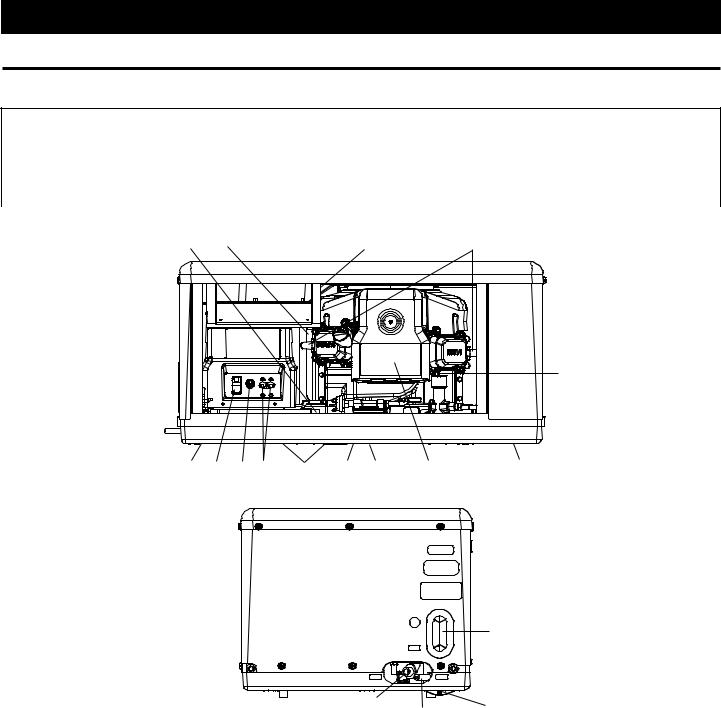
General Information
1.1GENERATOR IDENTIFICATION
Please record the following information from the generator DATA DECAL or information decal.
1. |
Model Number ____________________ |
2. |
Serial Number _________________ |
|
3. |
kW Rating _________________________ |
4. |
Rated Voltage _________________ |
|
5. |
Phase _____________________________ |
6. |
Hertz __________________________ |
|
|
|
|
|
|
|
18 |
8 |
2 |
15 |
13
10, 17 |
3 |
4 |
5 |
1 |
12 |
11 |
14 |
16 |
6
|
7 |
|
10 |
|
|
9, 17 |
|
|
REFERENCE NUMBER IDENTIFICATION |
||
1. |
Generator Air Intake |
10. |
Fuel Pump |
2. |
Data Plate |
11. |
Oil Filter |
3. |
Engine Start/Stop Switch |
12. |
Oil Drain Plug |
4. |
7.5 amp Fuse |
13. |
Oil Dipstick and Filler Tube |
5. |
Circuit Breaker |
14. |
Air Filter (Behind access panel.) |
6. |
Optional Remote Panel Receptacle |
15. |
Spark Plugs |
7. |
Generator AC Output Leads |
16. |
Exhaust Outlet |
8. |
Starter Contactor |
17. |
Fuel Filter |
9. |
Fuel Inlet |
18. |
Evaporative Port |
4
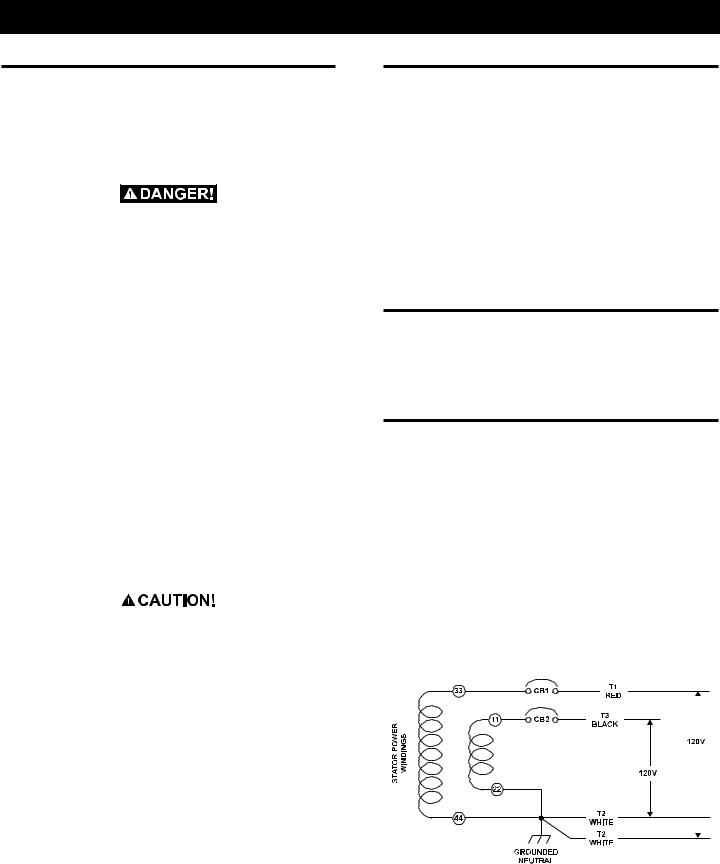
1.2GENERATOR APPLICABILITY
These generators have been designed and manufactured for supplying electrical power for recreational vehicles. DO NOT modify the generator or use it for any application other than for what it was designed. If there are any questions pertaining to its application, write or call the factory. Do not use the unit until advised by competent authority.
For fire safety, the generator must have been properly installed in compliance with ANSI 119.2-1975/NFPA 501C-1974, “Standard for Recreational Vehicles, Part III – Installation of Electrical Systems.” The generator also must have been installed in strict compliance with the manufacturer’s detailed installation instructions. After installation, do nothing that might render the unit in noncompliance with such codes, standards and instructions.
Use the generator set to supply electrical power for operating one of the following electrical loads:
•RV 45 G: 120 and/or 240 volts, single phase, 60 Hz electrical loads. These loads can require up to 4500 watts (4.5 kW) of total power, but cannot exceed 37.5 AC amperes of current at 120 volts (breaker is limited to 30 Amps).
•RV 55 G: 120 and/or 240 volts, single phase, 60 Hz electrical loads. These loads can require up to 5500 watts (5.5 kW) of total power, but cannot exceed 45.8 AC amperes of current at 120 volts or exceed 22.9 AC amperes at 240 volts.
•RV 65 G: 120 and/or 240 volts, single phase, 60 Hz electrical loads. These loads can require up to 6500 watts (6.5 kW) of total power, but cannot exceed 54.1 AC amperes of current at 120 volts or exceed 27 AC amperes at 240 volts.
nDo not overload the generator. Some installations may require that electrical loads be alternated to avoid overloading. Applying excessively high electrical loads may damage the generator and may shorten its
life. Add up the rated watts of all electrical lighting, appliance, tool and motor loads the generator will power at one time. This total should not be greater than the wattage capacity of the generator. If an electrical device nameplate gives only volts and amps, multiply volts times amps to obtain watts (volts x amps = watts). Some electric motors require more watts of power (or amps of current) for starting than for continuous operation.
General Information
1.3INSTALLATION
This Owner’s Manual has been prepared under the assumption that a competent, qualified technician installed the generator into a recreational vehicle. We also assume the installer complied with all applicable codes, standards and regulations pertaining to installation.
An INSTALLATION MANUAL was shipped with the generator. That Manual contains manufacturer’s instructions and recommendations for installing the unit into an industrial vehicle. After installation, installers should forward the Installation Manual to Owners/ Operators for their information.
Owners/Operators have the responsibility to make sure that nothing is done that might render the installation unsafe or in noncompliance with applicable codes, standards and instructions.
1.4SAFETY
Before using the generator set, carefully read GENERAL SAFETY RULES inside the cover. Comply with these RULES to prevent accidents and damage to equipment and/or property. The manufacturer suggests copying and posting the GENERAL SAFETY RULES to potential operators of this equipment.
1.5GENERATOR AC CONNECTION
SYSTEM
These air-cooled generator sets are equipped with dual stator AC power windings. These two stator windings supply electrical power to customer electrical loads by means of a dual 2-wire connection system.
Generators may be installed to provide the following outputs:
1.120 VAC loads only — two loads, each with a maximum total wattage requirement equal to half of the generator’s rated power output (in watts), and 120V across the generator output terminals. Figure 1.1 shows the generator lead wire connections for 120VAC ONLY.
Figure 1.1 – Connection for 120 Volts Only
5

General Information
2.120/240 VAC loads — one load with a maximum total wattage requirement equal to the generator’s rated power output, and 240V across the generator output terminals; or two separate loads, each with a maximum total wattage requirement equal to half of the generator’s rated power output (in watts), and 120V across the generator output terminals. Figure 1.2, shows the generator lead wire connections for 120/240 VAC loads. Also refer to the "Line Breakers" section for circuit breaker ratings.
This procedure should be done by an Authorized Service Dealer or other qualified installer.
Figure 1.2 - Connection for 120/240 Volts
T1
RED
CB1
T2
WHITE
|
CB2 |
T3 |
|
|
|
|
|
BLACK |
STATOR POWER |
GROUNDED NEUTRAL |
|
WINDINGS |
|
|
1.6SPECIFICATIONS
1.6.1FUEL REQUIREMENTS (GASOLINE)
This generator is equipped with a gasoline fuel system as standard equipment. Specific installations may provide either a separate fuel tank for the generator, or the generator may “share” the vehicle engine’s fuel tank.
1.6.1.1 Fuel Consumption (gph)
Model |
10% Load |
50% Load |
100% Load |
|
|
|
|
RV45G |
.33 |
.45 |
.73 |
RV55G |
.35 |
.55 |
.89 |
|
|
|
|
RV65G |
.37 |
.65 |
.97 |
|
|
|
|
NOTE
Some installations using a “shared” fuel tank may have a generator fuel pickup tube that is shorter than the vehicle engine’s pickup tube. Such an arrangement causes the generator engine to “run out of gas” while adequate fuel for the vehicle remains in the tank.
To reduce lead and carbon deposits use high quality UNLEADED gasoline with the generator. Leaded REGULAR grade gasoline is an acceptable substitute.
NOTE:
Using unleaded gasoline contributes to longer engine valve life by reducing lead and carbon deposits.
nThe manufacturer does not recommend using any gasoline containing alcohol (such as “gasohol”). If using any gasoline containing alcohol, it must not contain more than 10 percent ethanol (Do not use E85), and it must be removed from the generator during storage. Do NOT use any gasoline containing methanol. If using gasoline with alcohol, inspect more frequently for fuel leaks and other abnormalities.
1.6.2ENGINE OIL REQUIREMENTS
All oil should meet minimum American Petroleum Institute (API) Service Class SJ, SL or better. Use no special additives. Select the oil's viscosity grade according to the expected operating temperature (also see chart).
• SAE 30 Î Above 32° F |
|
• 10W-30 Î Between 40° F and -10° F |
|
• |
Synthetic 5W-30 Î 10° F and below |
|
SAE 30 |
|
10W-30 |
|
Synthetic 5W-30 |
Crankcase and oil filter capacity is approximately 1.4 L or 1.5 U.S. quarts. DO NOT use special additives. See sections "Checking the Engine Oil Level" and "Changing the Engine Oil and/or Oil Filter" for oil level check and filling procedures.
6

|
|
General Information |
||
|
|
|
|
|
|
|
|
|
|
1.6.3 GENERATOR SPECIFICATIONS |
|
|
|
|
SERIES |
RV45G |
RV55G |
|
RV65G |
|
|
|
|
|
Rotor RPM |
3600 |
3600 |
|
3600 |
Rotor Poles |
2 |
2 |
|
2 |
|
|
|
|
|
Engine RPM |
2571 |
2571 |
|
2571 |
|
|
|
|
|
Rated Max. Continuous AC Output Watts* |
4500 |
5500 |
|
6500 |
|
|
|
|
|
Voltage* |
120 |
120 |
|
120 |
|
|
|
|
|
Rated Max. Continuous Current Amps (240V) |
37.5 (18.7) |
45.8 (22.9) |
|
54.1 (27) |
|
|
|
|
|
Phase |
1 |
1 |
|
1 |
|
|
|
|
|
Frequency |
60 Hertz |
60 Hertz |
|
60 Hertz |
|
|
|
|
|
Weight |
278 lbs. |
285 lbs. |
|
293 lbs. |
|
|
|
|
|
Length |
33.7 in. |
33.7 in. |
|
33.7 in. |
Width |
21.5 in. |
21.5 in. |
|
21.5 in. |
|
|
|
|
|
Height |
16.8 in. |
16.8 in. |
|
16.8 in. |
|
|
|
|
|
* All units are re-connectable to 120 and/or 240 volts, dual voltage output. Units are not listed per RVIA/ANSI when reconnected for dual voltage output |
|
|||
** Maximum wattage and current are subject to, and limited by, such factors as fuel Btu content, ambient temperature, altitude, engine condition, etc.. Maximum power |
||||
decreases about 3.5% for each 1,000 feet above sea level; and will also decrease about 1% for each 6° C (10° F) above 16° C (60° F) ambient temperature. |
||||
|
|
|
|
|
1.6.4ENGINE SPECIFICATIONS
Type of Engine........................................................................ |
GT-530 |
Cooling Method................................................................ |
Air-cooled |
Rated Horsepower ................................................... |
18 at 3600 rpm |
Displacement ........................................................................... |
530cc |
Compression Ratio................................................................ |
8.5 to 1 |
Cylinder Block.................................. |
Aluminum w/Cast Iron Sleeve |
Type of Governor....................................... |
Electronic, Fixed Speed |
Engine Governor Speed................................................... |
2571 rpm |
Air Cleaner................................................................. |
Paper Element |
Starter .................................................................. |
12-volt DC Electric |
Ignition System ............................ |
Solid-state w/Flywheel Magneto |
Recommended Spark Plug |
|
NGK.................................................................................... |
BPR6HS |
Spark Plug Gap ............................................. |
0.030 inch (0.76 mm) |
Recommended Min. Battery.................. |
400 Cold Cranking Amps |
Class II Emission Certified |
|
1.7EXHAUST EMISSIONS
INFORMATION (GASOLINE)
The Environmental Protection Agency (EPA) and the California Air Resource Board (CARB) require that this generator comply with exhaust emission standards. The generator is certified to meet all applicable exhaust emission levels. This generator is certified for use as a mobile engine. It is important that you follow the maintenance specifications listed in this manual to ensure that the engine complies with emission standards for the duration of its life. This engine is certified to operate on gasoline. The emission control system on the generator consists of the following:
•Fuel Metering System
~Carburetor assembly
~Fuel pump and lines
•Air Induction System
~Intake pipe / manifold
~Air cleaner
•Ignition System
~Spark plug
~Ignition module
•Catalytic Converter (if equipped)
The Emissions Compliance Period referred to on the Emissions Compliance Label indicates the number of operating hours for which the engine has been shown to meet Federal and California emission requirements. See the table below to determine the compliance period for this generator. The displacement of the engine is listed on the Emissions Compliance Label.
Displacement |
Category |
Compliance Period |
|
A |
500 Hours |
|
|
|
> 66 cc - < 225 cc |
B |
250 Hours |
|
|
|
|
C |
125 HOurs |
|
|
|
|
A |
1000 Hours |
≥ 225 cc |
B |
500 Hours |
|
C |
250 Hours |
|
|
|
7
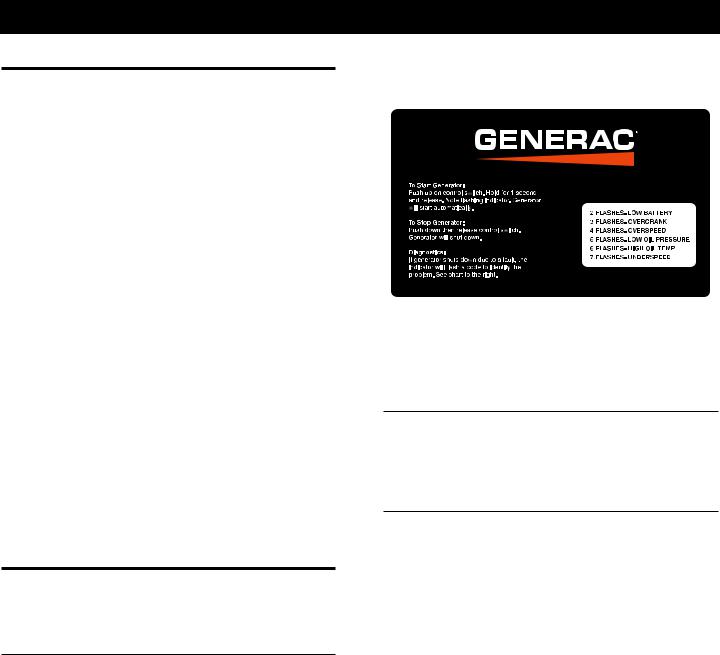
Operation
1.8EVAPORATIVE EMISSIONS
INFORMATION
This generator is subject to evaporative emission standards which have been implemented by the California Air Resource Board (CARB) and the Environmental Protection Agency (EPA). If this generator is offered for sale in the state of California, it must be covered by a CARB evaporative Executive Order. If this generator is offered for sale to the final consumer in any other state, certified low-permeation fuel line must be used to supply fuel to the generator as required by EPA.
Anyone who installs or configures a fuel system to supply this generator with gasoline is required to comply with all applicable evaporative emission regulations. If this generator is configured such that it shares the primary fuel system of a vehicle in which it is installed, reduced certification requirements may apply. See the CARB guidance document MAC 05-05, located at http://www.arb. ca.gov/msprog/macs/mac0505/mac0505.pdf for further details. If this generator is installed such that it uses a dedicated fuel system, detailed evaporative emission requirements apply; contact a reputable fuel system manufacturer to purchase a complete fuel system certified for use with this generator, or consult the California Code of Regulations if you wish to obtain certification on your own. See the installation instructions in this manual for connecting fuel system vapor lines to the engine.
This generator is not legal for sale in the state of California unless all CARB evaporative emission requirements are adhered to, and is not legal for sale in any other state unless certified low-per- meation fuel line is used to supply the generator with gasoline. Contact the California Air Resource Board or the Environmental protection agency for further information. CARB regulations can be found in 13 CCR §§2750 – 2773; EPA regulations can be found in 40 CFR Part 90.
2.1GENERATOR CONTROL PANEL
The following features are mounted on the generator control panel (Figure 2.1):
2.1.1START/STOP SWITCH
This generator is started with a "One Touch" starting sequence. Push up on the top half of the momentary switch. Hold for one
(1) second and release. Note flashing indicator light on the switch. Fuel pump engages automatically for a three (3) to five (5) second delay before starter motor cranks the engine for 16 seconds or until the engine starts. If the engine does not start, the starter will cool for seven (7) seconds and crank the engine again for 16 seconds. If the engine does not start, the starter will cool for seven
(7) seconds before cranking for seven (7) seconds to a maximum cycle total of 90 seconds. Once started, the light on the switch stays on continuously. If the generator does not start at the end of the start sequence, a fault code will flash on the switch (see Diagnostics).
The switch center position is the RUN position.
To stop a running engine, press momentarily the bottom half of the switch to kill the ignition.
Figure 2.1 – Typical Control Panel
The switch center position is the RUN position.
To stop a running engine, press momentarily the bottom half of the switch to kill the ignition.
2.1.27.5 AMP FUSE
The fuse protects the engine’s DC control circuit against electrical overload. If the fuse element has melted open due to overloading, the engine cannot be cranked. If the fuse must be replaced, use only an identical 7.5 amp replacement fuse.
2.1.3LINE BREAKERS
Protects generator’s AC output circuit against overload, i.e., prevents unit from exceeding wattage/amperage capacity. The circuit breaker ratings are as follows:
Model |
Cir. Breaker 1 |
Cir. Breaker 2 |
240 Volt |
|
|
|
|
RV45 |
30A |
N/A |
N/A |
|
|
|
|
RV55 |
20A |
30A |
25A 2P |
|
|
|
|
RV65 |
30A |
30A |
30A 2P |
NOTE:
If this generator has been reconnected for dual voltage AC output (120/240 volts), install line breakers having an amperage rating equal to that stated in the preceding chart. The replacement line breakers consist of two separate breakers with a connecting piece between the breaker handles (so that both breakers will operate at the same time). If the unit is reconnected for dual voltage, it is no longer RVIA listed.
8
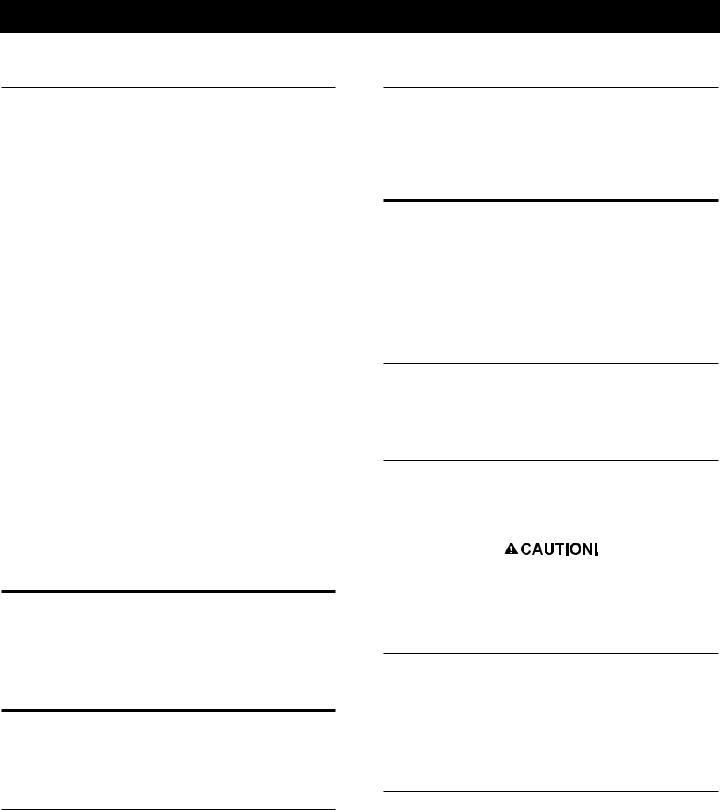
2.1.4DIAGNOSTICS
If the generator shuts down due to a fault, the indicator will flash a code to identify the problem.
• 2 Flashes = Low Battery (Voltage falls below 11.0 VDC for one minute)
NOTE:
Alarm will clear automatically if voltage rises over 11.0 VDC. Battery voltage is not monitored during crank cycle.
• 3 Flashes = Overcrank (Unit does not start through entire start cycle)
• 4 Flashes = Overspeed (Alternator spins at 4200 rpm/72 Hz or greater)
• 5 Flashes = Low Oil Pressure (Drops below the 5 psi threshold of the switch)
NOTE:
There is a five second delay of the alarm when the engine is first started up.
• 6 Flashes = High Oil Temperature (Unit shuts down when temperature switch limit is reached)
NOTE:
As the unit cools down it will attempt to restart automatically when the temperature switch opens again.
• 7 Flashes = Underspeed (Alternator spins less than 3240 rpm/54 Hz for three (3) seconds)
NOTE:
After a fault is indicated, press stop momentarily to clear the alarm once the problem is fixed.
2.2OPTIONAL REMOTE
START/STOP PANEL
A remote mounted Start/Stop Panel is available that allows starting and stopping the generator engine conveniently from inside the vehicle. The remote panel includes a Start/Stop switch, hourmeter, generator run lamp, and a wire harness.
2.3AUTOMATIC CHOKE
This engine is equipped with an automatic choke that consists of two main components: a choke solenoid and prechoke (Gasoline only.).
2.3.1CHOKE SOLENOID
During engine cranking (Start/Stop switch at START), a solid-state choke module signals the choke solenoid to activate and cycle (choke on/choke off) until the engine starts. The choke solenoid thus opens and closes the carburetor choke valve only when the engine is cranking. When the engine starts, the choke stops cycling (Gasoline only.).
Operation
2.3.2PRECHOKE
The choke system also has a temperature-sensitive metal strip that adjusts choke valve angle according to ambient temperatures (i.e., in cold ambient temperatures, choke valve closes more). Once the engine starts, an element heats the temperature-sensitive strip to a normal operating condition, opening the choke valve. This may take about three minutes in cooler weather (Gasoline only.).
2.4BEFORE STARTING THE ENGINE
NOTE:
Instructions and information in this manual assume the generator has been properly installed, connected, serviced, tested and adjusted by a qualified installation technician or installation contractor.
2.4.1INSTALLATION
Generator installation must have been properly completed so it complies with all applicable codes, standards and regulations and with the manufacturer's recommendations. (See Part II - Installation Instructions.)
2.4.2ENGINE LUBRICATION
Have the engine crankcase properly serviced with the recommended oil before starting. Refer to sections "Engine Specifications", "Checking the Engine Oil Level" and "Changing the Engine Oil and/ or Oil Filter" for oil servicing procedures and recommendations.
nAny attempt to crank or start the engine before it has been properly serviced it with the recommended oil may result in an engine failure.
2.4.3FUEL SUPPLY
The engine must have an adequate supply of proper fuel to operate. Before starting it, check that sufficient fuel is available.
NOTE:
Depending on the installation, the generator may have either a separate fuel tank, or it may “share” the vehicle engine’s fuel tank.
2.4.4COOLING AND VENTILATING AIR
Air inlet and outlet openings in the generator compartment must be open and unobstructed for continued proper operation. Without sufficient cooling and ventilating airflow, the engine/generator quickly overheats, which causes it to shut down and may damage the generator.
9

Operation
2.4.5ENGINE EXHAUST GAS
Before starting the generator engine, be sure there is no way for exhaust gases to enter the vehicle interior and endanger people or animals. Close windows, doors and other openings in the vehicle that, if open, might permit exhaust gases to enter the vehicle.
nThe generator engine releases DEADLY carbon monoxide gas through its exhaust system. This dangerous gas, if breathed in sufficient concentrations, can cause unconsciousness or even death. Never operate the generator set with the vehicle inside any garage or other enclosed area. DO NOT
OPERATE THE GENERATOR IF THE EXHAUST SYSTEM IS LEAKING OR HAS BEEN DAMAGED. Shut down the generator and
do not operate it until it has been inspected and repaired. SYMPTOMS OF CARBON MONOXIDE POISONING ARE (a) inability to think coherently, (b) nausea, (c) vomiting, (d) twitching muscles, (e) throbbing temples, (f) dizziness, (g) headaches, (h) weakness, and
(i) sleepiness. IF EXPERIENCING ANY OF THESE SYMPTOMS, MOVE INTO FRESH AIR IMMEDIATELY. IF SYMPTOMS PERSIST, GET MEDICAL HELP.
nNever sleep in the vehicle while the genset is running unless the vehicle has a working carbon monoxide detector. The exhaust system must be installed in accordance with the genset installation manual. Make sure there is ample fresh air when operating the genset in a confined area.
2.5STARTING THE GENERATOR
NOTE:
Read the vehicle manufacturer’s instructions. The owner/ operator should become familiar with the vehicle in which this generator is installed. Differences exist between vehicles. For example, some vehicles may use a transfer switch to isolate dockside power from the generator, while other vehicles may use an isolating receptacle. Some vehicles may be equipped with a DC converter which allows the generator to power certain DC lighting and other DC loads.
To crank and start the generator engine, proceed as follows:
1.Turn OFF electrical loads using the means provided in the vehicle (such as a main line circuit breaker or transfer switch).
NOTE:
If starting from the generator control panel, turn OFF loads by setting the generator’s main circuit breaker to the OFF (or open) position. If starting from a remote panel, turn OFF loads using the means provided in the vehicle (such as a main circuit breaker). Electrical load circuits should be turned ON after the generator has started, stabilized and warmed up.
2.To crank and start the engine, push up on the Start/Stop switch momentarily and release. There is a delay as the fuel pump primes and the generator automatically begins the start sequence (Note the flashing light on the switch.).
3.Let the engine run at no-load for a few minutes to stabilize and warm up.
4.Turn ON electrical loads using the means provided (such as a main circuit breaker or transfer switch).
2.6STOPPING THE GENERATOR
1.Turn OFF all electrical loads using the means provided (such as a main circuit breaker or transfer switch).
2.Let generator run at no-load for a few minutes, to stabilize internal engine generator temperatures.
3.Place the Start/Stop switch in its STOP position. The engine will come to a complete stop.
2.7APPLYING LOADS TO
GENERATOR
When applying electrical loads to the generator, observe these guidelines:
•Before applying electrical loads, let the generator stabilize and warm up for a minute or two.
•DO NOT overload the generator.
2.7.1LETTING THE ENGINE STABILIZE
The generator supplies correct rated voltage only at the proper governed speed. Some electrical appliances may be extremely sensitive to voltage. Incorrect voltages can damage such appliances.
If electrical loads are applied at reduced operating speeds, such loads imposed on the engine when sufficient power is not available may shorten engine life. Never turn ON electrical loads until after the generator engine has started and stabilized at no-load.
2.7.2DO NOT OVERLOAD THE GENERATOR
Read the rated wattage/amperage capacity of the generator on the generator data label (See the "Generator Identification" section.).
Applying electrical loads in excess of the unit’s rated capacity will cause the engine/generator to automatically shut down.
To avoid overloading, add up the wattage of all connected electrical lighting, appliance, tool and motor loads. This total should not be greater than the generator’s rated wattage capacity.
10
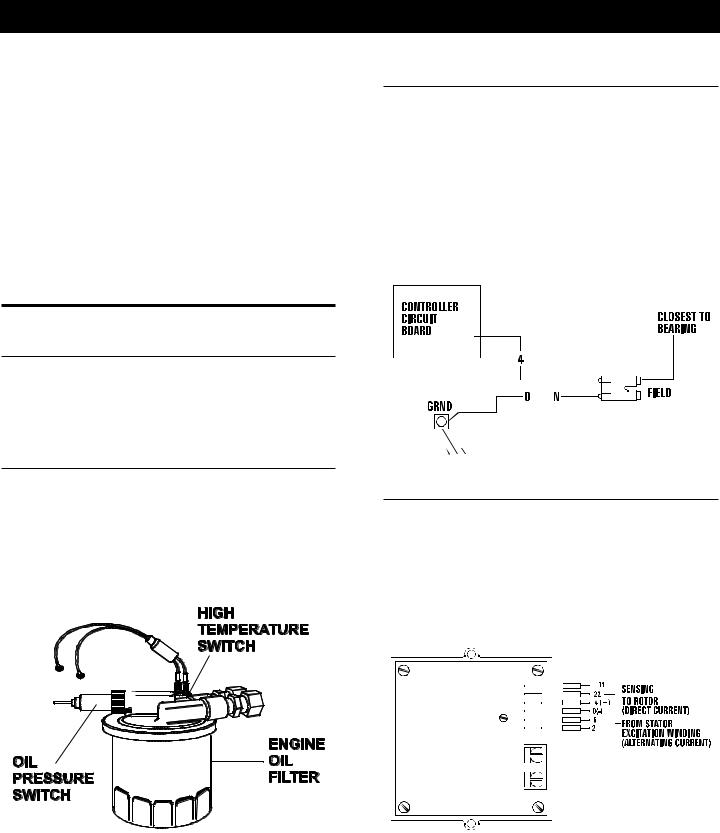
•Most lighting, appliance, tool and motor loads indicate their required watts on their nameplate or data plate. For light bulbs, simply note the wattage rating of the bulb.
•If a load does not show its rated wattage, multiply that load’s rated VOLTS times AMPS to obtain WATTS.
•Induction type motors (such as those that run the vehicle’s furnace fan, refrigerator, air conditioner, etc.) need about 2-1/2 times more watts of power for starting than for running (for a few seconds during motor starting). Be sure to allow for this when connecting electrical loads to the generator. First, figure the watts needed to start electric motors in the system. To that figure, add the running wattages of other items that will be operated by the generator.
•Do not apply heavy electrical loads for the first two or three hours of operation.
2.8PROTECTION SYSTEMS
2.8.1LOW OIL PRESSURE SWITCH
This switch (Figure 2.2) has normally closed (N.C.) contacts that are held open by engine oil pressure during cranking and operating. Should oil pressure drop below a preset level, switch contacts close, and the engine automatically shuts down. The unit should not be restarted until oil is added.
2.8.2HIGH TEMPERATURE SWITCH
This switch (Figure 2.2), which has normally open (N.O.) contacts, is mounted near the oil filter. The contacts close if the temperature should exceed approximately 270º F (132º C) for gasoline models.
Figure 2.2 – Low Oil Pressure and
High Temperature Switches
Operation
2.8.3FIELD BOOST
The Controller Circuit Board houses a field boost diode and resistor that are not part of the automatic choke circuit. These two components are part of a “field boost” circuit (Figure 2.3). During engine cranking only, a positive DC (battery) voltage is delivered through a diode, resistor, brushes, slip rings, and the generator rotor. Application of this voltage to the rotor “flashes the field” whenever it is started. Flashing of the field each time the generator starts makes sure that a sufficiently strong magnetic field is available to produce “pickup” voltage in the stator windings.
Figure 2.3 – Field Boost Circuit
2.8.4OVERVOLTAGE PROTECTION
A solid-state voltage regulator (Figure 2.4) controls the generator’s AC output voltage. This regulator supplies an excitation current to the rotor. By regulating the rotor’s excitation current, the strength of its magnetic field is regulated and, in turn, the voltage delivered to connected electrical loads is controlled. When the AC frequency is 60 Hertz, voltage is regulated at 125 to 120 volts.
Figure 2.4 – Solid State Voltage Regulator
11
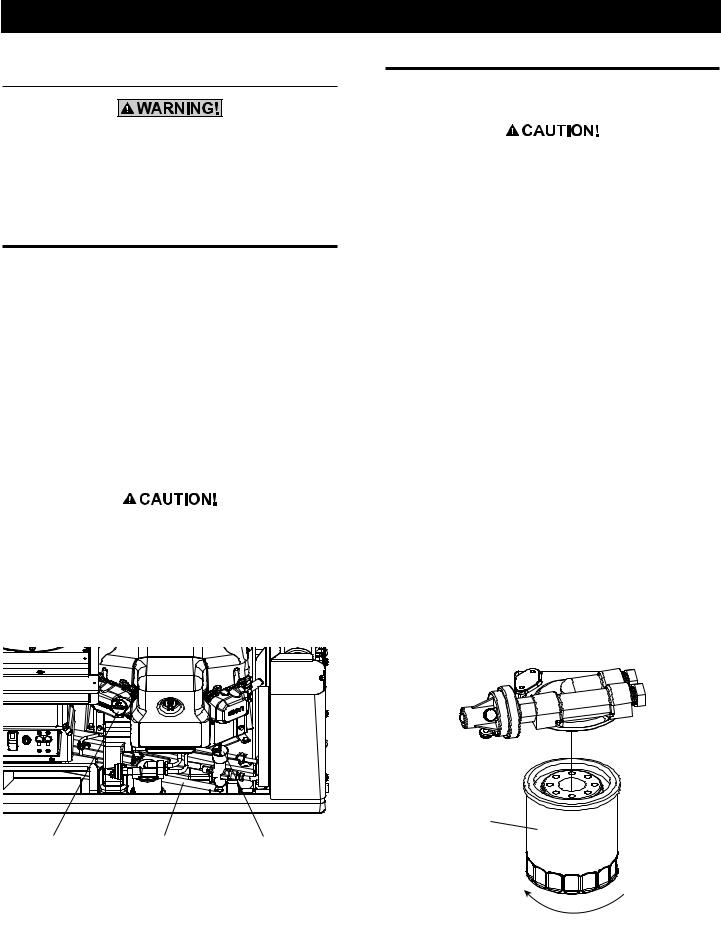
Maintenance
2.8.5OPERATION IN HIGH GRASS OR BRUSH
Never operate the generator while the vehicle is parked over high grass, weeds, brush, leaves or any other combustible substance. Such materials can ignite and burn from the heat of the exhaust system. The generator exhaust system becomes extremely hot during operation and remains hot for a long time after it has shut down.
3.1CHECKING THE ENGINE OIL
LEVEL
For oil capacities and requirements, see the “Engine Oil Requirements” section. Check the engine crankcase oil level at least every eight hours of operation, or before it is used. To check the engine oil level, proceed as follows (see Figure 3.1):
1.Be sure the generator is as level as possible.
2.Remove the dipstick and wipe it dry with a clean, lint-free cloth.
3.Install and tighten the dipstick cap; then, remove it again. The oil level should be at the dipstick “Full” mark.
4.If necessary, remove the oil fill cap on the rocker cover and slowly add oil until it reaches the dipstick “Full” mark. DO NOT FILL ABOVE THE “FULL” MARK.
nNever operate the engine with the oil level below the “Add” mark on the dipstick. Doing this could damage the engine.
5.Install and tighten the oil fill cap and the dipstick before operating the engine.
Figure 3.1 — Oil Dipstick/Fill Tube and
Location of Oil Drain Plug
Oil Fill |
Oil Drain Hose |
Oil Dipstick |
3.2CHANGING THE ENGINE OIL AND/OR OIL FILTER
nHot oil may cause burns. Allow engine to cool before draining oil. Avoid prolonged or repeated skin exposure with used oil.
Thoroughly wash exposed areas with soap.
Oil Change Intervals – see Section “RV Generator Service Interval”.
To change the oil and oil filter, proceed as follows:
1.Run the engine until it is thoroughly warmed up (at least five minutes) then shut off the engine.
2.With the engine still warm from running, remove the round access grommet from underneath the front of the generator. Place a suitable container underneath to catch all the drain oil.
3.Use the 0G4818 tool (supplied with the generator) to turn the old filter counter-clockwise and remove. Let oil drain into the container located directly below.
4.Locate the oil drain hose inside and pull the yellow drain plug out of the access hole (Figure 3.1).
5.Turn the yellow cap counter-clockwise to remove and finish draining the old oil.
6.After the oil has been drained, replace the oil drain plug by tightening it clockwise and return.
7.Clean off the oil filter bracket and any old oil that may have spilled while draining.
8.Apply a light coating of clean engine oil the gasket of the new oil filter (Figure 3.2).
9.Screw the new oil filter on by hand until its gasket lightly contacts the oil filter adapter. Then, tighten the filter an additional ¾ to one turn. Replace and secure the round access grommet.
Figure 3.2 — Engine Oil Filter
Engine
Oil Filter
Twist Counter-clockwise to Loosen
12
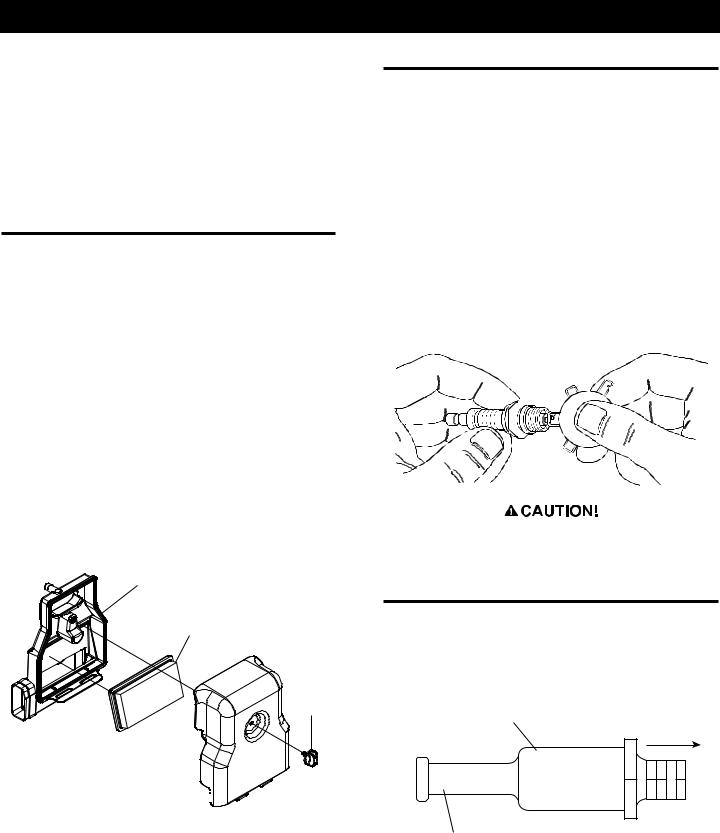
10.Remove the dipstick, valve cover plug and add new oil (see “Engine Oil Requirements”) to engine. DO NOT FILL ABOVE THE “FULL” MARK.
11.Install and tighten plug and dipstick before starting the engine.
12.Start engine and check for leaks.
NOTE:
Check the oil level and fill to the “FULL” mark after checking for leaks. The filter will retain some oil.
3.3MAINTAINING THE ENGINE
AIR CLEANER
Replace the paper air filter element after every 200 hours of operation. (Perform more often when operating in dusty conditions)
1.At the Air Cleaner Cover, turn the yellow plastic knob ¼ turn counter-clockwise.
2.Pull the top of the Cover out as it hinges on the bottom of the Air Cleaner Base.
3.Separate the Cover by lifting up and out from the Base.
4.Pull the old filter out and discard safely.
5.Install the new filter in place on the Air Cleaner Base (Figure 3.3).
6.Interlock the Air Cleaner Cover to hinge with the Air Cleaner Base.
7.Align the Cover and gently push the top closed.
8.Engage the yellow plastic knob and turn ¼ turn clockwise to secure.
Figure 3.3 – Engine Air Cleaner
Air Cleaner Base
Air Cleaner
Knob
Air Cleaner Cover 

Maintenance
3.4CHECKING THE ENGINE
SPARK PLUG
Reset the spark plug gap or replace the spark plugs as necessary. See the Service Schedule section for maintenance requirements.
1.Clean the area around the base of the spark plugs to keep dirt and debris out of the engine.
2.Remove the spark plugs and check the condition. Replace the spark plugs if worn or if reuse is questionable. See the Service Schedule section for recommended interval. Clean by scraping or washing using a wire brush and commercial solvent. Do not blast the spark plugs to clean.
3.Check the spark plug gap using a wire feeler gauge. Adjust the gap to 0.76mm (0.030 inch) by carefully bending the ground electrode if necessary (Figure 3.4).
Figure 3.4 – Setting the Spark Plug Gap
nSparking can occur if the wire terminal does not fit firmly on the spark plug terminal end. If necessary, re-form the wire terminal to obtain a tight fit.
3.5FUEL FILTER (GASOLINE ONLY)
Remove and replace the fuel filter (Figure 3.5) every 400 hours of operation.
Figure 3.5 – Fuel Filter
FUEL FILTER |
TO FUEL PUMP |
|
CUSTOMER FUEL CONNECTION
13
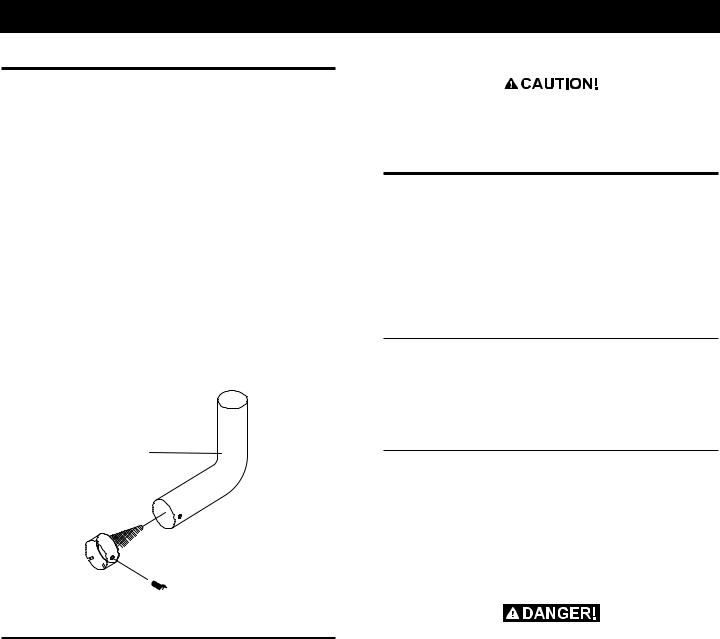
Maintenance
3.6CLEAN SPARK ARRESTOR
The engine exhaust muffler has a spark arrestor screen. Inspect and clean the screen every 200 hours of operation or once each year, whichever comes first.
NOTE:
If using the generator on any forest-covered, brush-covered or grass-covered unimproved land, it must equipped with a spark arrestor. The spark arrestor must be maintained in good condition by the owner/operator.
Clean and inspect the spark arrestor as follows:
•Remove the screen by removing the screw.
•Slide the spark arrestor screen out from the tail pipe.
•Inspect screen and replace if torn, perforated or otherwise damaged. DO NOT USE a defective screen. If screen is not damaged, clean it with commercial solvent.
•Replace the screen and the screw.
Figure 3.6 - Spark Arrestor
TAILPIPE
P/N 0G5857

 SPARK ARRRESTOR
SPARK ARRRESTOR
SCREEN P/N 089680
RETAINING 



SCREW P/N 056892
3.7CLEANING THE GENERATOR
Keep the generator set as clean and dry as possible. Protect the unit against excessive dust, dirt, corrosive vapors, road splash, etc. Permitting dirt and moisture to accumulate on generator windings will have an adverse effect on the insulation resistance of those windings.
When moisture is allowed to remain in contact with windings, some of the moisture will be retained in voids and cracks in the insulation. This causes a reduced insulation resistance and will eventually cause problems. Dirt will make the problem worse, since dirt tends to hold moisture in contact with windings. Salt (as from sea air) also will worsen the problem since it tends to absorb moisture from the air. Salt and moisture, when combined, form a good electrical conductor which is detrimental to the generator.
nDo NOT use a forceful spray of water to clean the generator. Water will enter the generator interior and cause problems, and may also contaminate the generator fuel system.
3.8BATTERY MAINTENANCE
NOTE:
This generator is not equipped with an internal battery charger. It is intended for use in systems where an external battery charger is installed by the RV O.E.M. or an aftermarket installer.
All lead-acid batteries will discharge when not in use. The generator battery should be inspected as follows:
3.8.1WEEKLY
•Inspect the battery posts and cables for tightness and corrosion. Tighten and clean as necessary.
•Check the battery fluid level of unsealed batteries and, if necessary, fill with Distilled Water Only. Do not use tap water in batteries.
3.8.2EVERY SIX MONTHS
•Have the state of charge and condition checked. This should be done with an automotive-type battery hydrometer.
NOTE:
Servicing of the battery is to be performed or supervised by personnel knowledgeable of batteries and the required precautions. Keep unauthorized personnel away from batteries.
Damage will result if the battery connections are made in reverse.
Do not dispose of the battery in a fire. The battery is capable of exploding. Storage batteries give off explosive hydrogen gas. This gas can form an explosive mixture around the battery for several hours after charging. The slightest spark can ignite the gas and cause an explosion. Such an explosion can shatter the battery and cause blindness or other injury. Any area that houses a storage battery must be properly ventilated. Do not allow smoking, open flame, sparks, or any spark producing tools or equipment near the battery. Discharge static electricity from body before touching the battery by first touching a grounded metal surface.
14
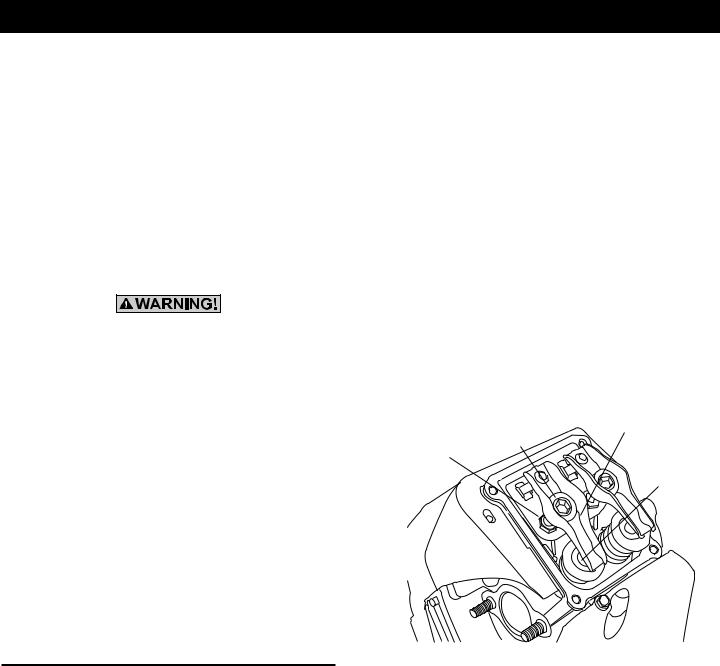
A battery presents a risk of electrical shock and high short circuit current. The following precautions are to be observed when working on batteries:
•Remove watches, rings or other metal objects;
•Use tools with insulated handles;
•Wear rubber gloves and boots;
•Do not lay tools or metal parts on top of the battery;
•Disconnect any charging source prior to connecting or disconnecting battery terminals; and
•Do not use any jumper cables or booster battery to crank and start the generator engine. If any battery has discharged, remove it for recharging.
nDo not open or mutilate the battery.
Released electrolyte has been known to be harmful to the skin and eyes, and to be toxic.
nThe electrolyte is a dilute sulfuric acid that is harmful to the skin and eyes. It is electrically conductive and corrosive. The following procedures are to be observed:
•Wear full eye protection and protective clothing;
•Where electrolyte contacts the skin, wash it off immediately with water;
•Where electrolyte contacts the eyes, flush thoroughly and immediately with water and seek medical attention; and
•Spilled electrolyte is to be washed down with an acid neutralizing agent. A common practice is to use a solution of 1 pound (500 grams) bicarbonate of soda to 1 gallon (4 liters) or water. The bicarbonate of soda solution is to be added until the evidence of reaction (foaming) has ceased. The resulting liquid is to be flushed with water and the area dried.
3.9ADJUSTING VALVE CLEARANCE
After the first 50 hours of operation, check the valve clearance in the engine, adjust if necessary.
Important: If feeling uncomfortable about doing this procedure or the proper tools are not available, please contact the Authorized Dealer for service assistance. This is a very important step to insure longest life for the engine.
To check valve clearance:
•The engine should be cool before checking. If valve clearance is 0.002" - 0.004" (0.05 - 0.1mm), adjustment is not needed.
•Remove spark plug wires and position wires away from plugs.
•Remove spark plugs.
Maintenance
•Make sure the piston is at Top Dead Center (TDC) of its compression stroke (both valves closed). To get the piston at TDC, remove the intake screen at the front of the engine to gain access to the flywheel nut. Use a large socket and socket wrench to rotate the nut and hence the engine in a clockwise direction. While watching the piston through the spark plug hole. The piston should move up and down. The piston is at TDC when it is at its highest point of travel.
To adjust valve clearance (if necessary):
•Make sure the engine is at 60° to 80° F.
•Make sure that the spark plug wire is removed from the spark plug and out of the way.
•Remove the four screws attaching the valve cover with a #2 or #3 Phillips screwdriver.
•Loosen the rocker jam nut. Use an 10mm allen wrench to turn the pivot ball stud while checking clearance between the rocker arm and the valve stem with a feeler gauge. Correct clearance is 0.002-0.004 inch (0.05-0.1 mm). (Figure 3.7).
Figure 3.7 - Valve Clearance Adjustment
Rocker
Pivot Ball Arm
Stud
Jam Nut
Valve
Stem
NOTE:
Hold the rocker arm jam nut in place as the pivot ball stud is turned.
When valve clearance is correct, hold the pivot ball stud in place with the allen wrench and tighten the rocker arm jam nut. Tighten the jam nut to 174 in/lbs. torque. After tightening the jam nut, recheck valve clearance to make sure it did not change.
•Install new valve cover gasket.
•Re-attach the valve cover.
NOTE:
Start all four screws before tightening or it will not be possible to get all the screws in place. Make sure the valve cover gasket is in place.
•Install spark plugs.
•Re-attach the spark plug wire to the spark plug.
•On the GT-530, repeat the process for the other cylinder.
15
